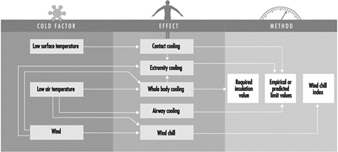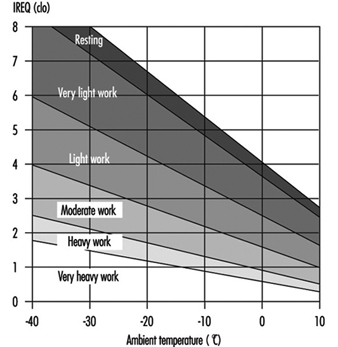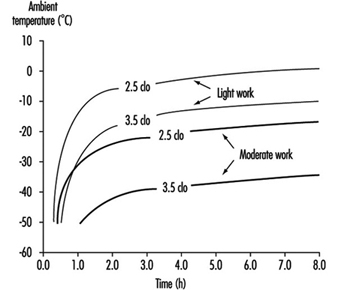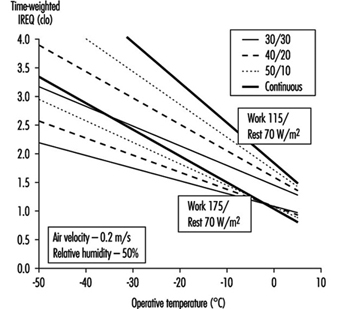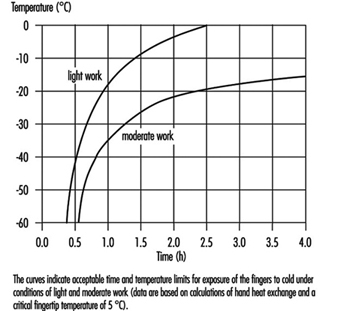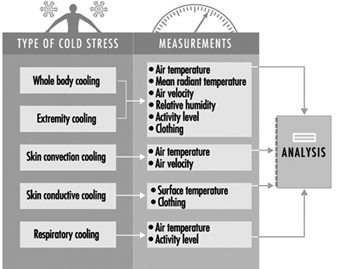Cold stress is defined as a thermal load on the body under which greater than normal heat losses are anticipated and compensatory thermoregulatory actions are required to maintain the body thermally neutral. Normal heat losses, hence, refer to what people normally experience during indoor living conditions (air temperature 20 to 25ºC).
In contrast to conditions in the heat, clothing and activity are positive factors in the sense that more clothing reduces heat loss and more activity means higher internal heat production and a greater potential for balancing heat loss. Accordingly, assessment methods focus on the determination of required protection (clothing) at given activity levels, required activity levels for given protection or “temperature” values for given combinations of the two (Burton and Edholm 1955; Holmér 1988; Parsons 1993).
It is important to recognize, however, that there are limits as to how much clothing can be worn and how high a level of activity can be sustained for extended time periods. Cold-protective clothing tends to be bulky and hobbling. More space is required for motion and movements. Activity level may be determined by paced work but should, preferably, be controlled by the individual. For each individual there is a certain highest energy production rate, depending on physical work capacity, that can be sustained for prolonged time periods. Thus, high physical work capacity may be advantageous for prolonged, extreme exposures.
This article deals with methods for assessment and control of cold stress. Problems related to organizational, psychological, medical and ergonomic aspects are dealt with elsewhere.
Cold Work
Cold work encompasses a variety of conditions under natural as well as artificial conditions. The most extreme cold exposure is associated with missions in outer space. However, cold working conditions on the surface of the earth cover a temperature range of more than 100ºC (table 1). Naturally, the magnitude and severity of cold stress will be expected to increase with lowered ambient temperature.
Table 1. Air temperatures of various cold occupational environments
|
–120 ºC |
Climatic chamber for human cryotherapy |
|
–90 ºC |
Lowest temperature at south polar base Vostock |
|
–55 ºC |
Cold store for fish meat and production of frozen, dried products |
|
–40 ºC |
“Normal” temperature at polar base |
|
–28 ºC |
Cold store for deep-frozen products |
|
+2 to +12 ºC |
Storage, preparation and transportation of fresh, alimentary products |
|
–50 to –20 ºC |
Average January temperature of northern Canada and Siberia |
|
–20 to –10 ºC |
Average January temperature of southern Canada, northern Scandinavia, central Russia |
|
–10 to 0 ºC |
Average January temperature of northern USA, southern Scandinavia, central Europe, parts of middle and far East, central and northern Japan |
Source: Modified from Holmér 1993.
It is clear from 1 table that large populations of outdoor workers in many countries experience more or less severe cold stress. In addition cold store work occurs in all parts of the world. Surveys in Scandinavian countries reveal that approximately 10% of the total worker population regard cold as a major annoyance factor in the workplace.
Types of Cold Stress
The following types of cold stress can be defined:
- whole-body cooling
- local cooling, including extremity cooling, convective skin cooling (wind chill), conductive skin cooling (contact cooling) and cooling of respiratory tract.
Most likely, several if not all of these may be present at the same time.
The assessment of cold stress involves the ascertainment of a risk of one or more of the mentioned effects. Typically, table 2 may be used as a first rough classification. In general cold stress increases, the lower the level of physical activity and the less protection available.
Table 2. Schematic classification of cold work
|
Temperature |
Type of work |
Type of cold stress |
|
10 to 20 ºC |
Sedentary, light work, fine manual work |
Whole-body cooling, extremity cooling |
|
0 to 10 ºC |
Sedentary and stationary, light work |
Whole-body cooling, extremity cooling |
|
–10 to 0 ºC |
Light physical work, handling tools and materials |
Whole-body cooling, extremity cooling, contact cooling |
|
–20 to –10 ºC |
Moderate activity, handling metals and fluids (petrol etc.), windy conditions |
Whole-body cooling, extremity cooling, contact cooling, convective cooling |
|
Below –20 ºC |
All types of work |
All types of cold stress |
Information given in the table should be interpreted as a signal to action. In other words, the particular type of cold stress should be evaluated and controlled, if required. At moderate temperatures problems associated with discomfort and losses of function due to local cooling prevail. At lower temperatures the imminent risk of a cold injury as a sequel to the other effects is the important factor. For many of the effects discrete relationships between stress level and effect do not yet exist. It cannot be excluded that a particular cold problem may persist also outside the range of temperatures denoted by the table.
Assessment Methods
Methods for assessment of cold stress are presented in ISO Technical Report 11079 (ISO TR 11079, 1993). Other standards concerning determination of metabolic heat production (ISO 8996, 1988), estimation of clothing thermal characteristics (ISO 9920, 1993), and physiological measurements (ISO DIS 9886, 1989c) provide complementary information useful for the evaluation of cold stress.
Figure 1 outlines the relationships between climate factors, anticipated cooling effect and recommended method for assessment. Further details about methods and data collection are given below.
Figure 1. Assessment of cold stress in relation to climatic factors and cooling effects.
Whole-Body Cooling
The risk of whole-body cooling is determined by analysing the conditions for body heat balance. The clothing insulation level required for heat balance at defined levels of physiological strain, is calculated with a mathematical heat balance equation. The calculated required insulation value, IREQ, can be regarded as a cold stress index. The value indicates a protection level (expressed in clo). The higher the value, the greater the risk of body heat imbalance. The two levels of strain correspond to a low level (neutral or “comfort” sensation) and a high level (slightly cold to cold sensation).
Using IREQ comprises three evaluation steps:
- determination of IREQ for given exposure conditions
- comparison of IREQ with protection level provided by clothing
- determination of exposure time if protection level is of lesser value than IREQ
Figure 2 shows IREQ values for low physiological strain (neutral thermal sensation). Values are given for different activity levels.
Figure 2. IREQ values needed to maintain low-level physiological strain (neutral thermal sensation) at varying temperature.
Methods to estimate activity levels are described in ISO 7243 (table 3).
Table 3. Classification of levels of metabolic rate
|
Class |
Metabolic rate range, M |
Value to be used for calculation of mean metabolic rate |
Examples |
||
|
Related to |
For a mean skin surface area |
|
|
||
|
0 |
M≤65 |
M≥117 |
65 |
117 |
Resting |
|
1 |
65M≤130 |
117M≤234 |
100 |
180 |
Sitting at ease: light manual work (writing, typing, drawing, sewing, book-keeping); hand and arm work (small bench tools, inspection, assembly or sorting of light material); arm and leg work (driving vehicle in normal conditions, operating foot switch or pedals). Standing: drill (small parts); milling machine (small parts); coil winding; small armature winding; machining with low power tools; casual walking (speed up to 3.5 km/h). |
|
2 |
130M≤200 |
234M≤360 |
165 |
297 |
Sustained hand and arm work (hammering in nails, filling); arm and leg work (off-road operation of lorries, tractors or construction equipment); arm and trunk work (work with pneumatic hammer, tractor assembly, plastering, intermittent handling of moderately heavy material, weeding, hoeing, picking fruit or vegetables); pushing or pulling light weight carts or wheelbarrows; walking at a speed of 3.5 km/h; forging. |
|
3 |
200M≤260 |
360M≤468 |
230 |
414 |
Intense arm and trunk work: carrying heavy material; shoveling; sledge hammer work; sawing, planning or chiselling hard wood; hand mowing; digging; walking at a speed of 5.5 km/h to 7 km/h. Pushing or pulling heavily loaded handcarts or wheelbarrows; chipping castings; concrete block laying. |
|
4 |
M>260 |
M>468 |
290 |
522 |
Very intensive activity at fast to maximum pace; working with an axe; intense shovelling or digging; climbing stairs, ramp or ladder; walking quickly with small steps, running, walking at a speed greater than 7 km/h. |
Source: ISO 7243 1989a
Once IREQ is determined for given conditions, the value is compared with the protection level offered by clothing. Protection level of a clothing ensemble is determined by its resultant insulation value (“clo-value”). This property is measured according to the draft European standard prEN-342 (1992). It can also be derived from basic insulation values provided in tables (ISO 9920).
Table 4. provides examples of basic insulation values for typical ensembles. Values must be corrected for presumed reduction caused by body motion and ventilation. Typically, no correction is made for resting level. Values are reduced by 10% for light work and by 20% for higher activity levels.
Table 4. Examples of basic insulation values (Icl) of clothing*
|
Clothing ensemble |
Icl (m2 ºC/W) |
Icl (clo) |
|
Briefs, short-sleeve shirt, fitted trousers, calf-length socks, shoes |
0.08 |
0.5 |
|
Underpants, shirt, fitted, trousers, socks, shoes |
0.10 |
0.6 |
|
Underpants, coverall, socks, shoes |
0.11 |
0.7 |
|
Underpants, shirt, coverall, socks, shoes |
0.13 |
0.8 |
|
Underpants, shirt, trousers, smock, socks, shoes |
0.14 |
0.9 |
|
Briefs, undershirt, underpants, shirt, overalls, calf-length socks, shoes |
0.16 |
1.0 |
|
Underpants, undershirt, shirt, trousers, jacket, vest, socks, shoes |
0.17 |
1.1 |
|
Underpants, shirt, trousers, jacket, coverall, socks, shoes |
0.19 |
1.3 |
|
Undershirt, underpants, insulated trousers, insulated jacket, socks, shoes |
0.22 |
1.4 |
|
Briefs, T-shirt, shirt, fitted trousers, insulated coveralls, calf-length socks, shoes |
0.23 |
1.5 |
|
Underpants, undershirt, shirt, trousers, jacket, overjacket, hat, gloves, socks, shoes |
0.25 |
1.6 |
|
Underpants, undershirt, shirt, trousers, jacket, overjacket, overtrousers, socks, shoes |
0.29 |
1.9 |
|
Underpants, undershirt, shirt, trousers, jacket, overjacket, overtrousers, socks, shoes, hat, gloves |
0.31 |
2.0 |
|
Undershirt, underpants, insulated trousers, insulated jacket, overtrousers, overjacket, socks, shoes |
0.34 |
2.2 |
|
Undershirt, underpants, insulated trousers, insulated jacket, overtrousers, socks, shoes, hat, gloves |
0.40 |
2.6 |
|
Undershirt, underpants, insulated trousers, insulated jacket, overtrousers and parka with lining, socks, shoes, hat, mittens |
0.40–0.52 |
2.6–3.4 |
|
Arctic clothing systems |
0.46–0.70 |
3–4.5 |
|
Sleeping bags |
0.46–1.1 |
3–8 |
*Nominal protection level applies only to static, windstill conditions (resting). Values must be reduced with increased activity level.
Source: Modified from ISO/TR-11079 1993.
The protection level offered by the best available clothing systems corresponds to 3 to 4 clo. When the available clothing system does not provide sufficient insulation, a time limit is calculated for the actual conditions. This time limit depends on the difference between required clothing insulation and that of the available clothing. Since, full protection against cooling is no longer achieved, the time limit is calculated on the basis of an anticipated reduction of body heat content. Similarly, a recovery time can be calculated to restore the same amount of heat.
Figure 3 shows examples of time limits for light and moderate work with two insulation levels of clothing. Time limits for other combinations may be estimated by interpolation. Figure 4 can be used as a guideline for assessment of exposure time, when the best cold protective clothing is available.
Figure 3. Time limits for light and moderate work with two insulation levels of clothing.
Figure 4. Time-weighted IREQ values for intermittent and continuous exposure to cold.
Intermittent exposures typically comprise work periods interrupted by warm-up breaks or by work periods in a warmer environment. In most conditions, little or no replacement of clothing takes place (mostly for practical reasons). IREQ may then be determined for the combined exposure as a time-weighted average. Averaging period must not be longer than one to two hours. Time-weighted IREQ values for some types of intermittent exposure are given in figure 4.
IREQ values and time limits should be indicative rather than normative. They refer to the average person. The individual variation in terms of characteristics, requirements and preferences is large. Much of this variation must be handled by selecting clothing ensembles with great flexibility in terms of, for example, adjustment of the protection level.
Extremity Cooling
The extremities—in particular, fingers and toes—are susceptible to cooling. Unless sufficient heat input by warm blood can be maintained, tissue temperature progressively falls. Extremity blood flow is determined by energetic (required for muscles activity) as well as thermoregulatory needs. When whole-body thermal balance is challenged, peripheral vasoconstriction helps to reduce core heat losses at the expense of peripheral tissues. With high activity more heat is available and extremity blood flow can more easily be maintained.
The protection offered by handwear and footwear in terms of reducing heat losses is limited. When heat input to the extremity is low (e.g., with resting or low activity), the insulation required to keep hands and feet warm is very large (van Dilla, Day and Siple 1949). The protection offered by gloves and mittens only provides retardation of cooling rate and, correspondingly, longer times to reach a critical temperature. With higher activity levels, improved protection allows warm hands and feet at lower ambient temperatures.
No standard method is available for assessment of extremity cooling. However, ISO TR 11079 recommends 24ºC and 15ºC as critical hand temperatures for levels of low and high stress, respectively. Fingertip temperature may easily be 5 to 10 °C lower than the average hand skin temperature or simply the temperature of the back of the hand.
The information given in figure 5 is useful when determining acceptable exposure times and required protection. The two curves refer to conditions with and without vasoconstriction (high and low activity level). Furthermore, it is assumed that finger insulation is high (two clo) and adequate clothing is used.
Figure 5. Finger protection.
A similar set of curves should apply to toes. However, more clo may be available for protection of feet, resulting in longer exposure times. Nevertheless, it follows from figures 3 and 5 that extremity cooling most likely is more critical for exposure time than whole-body-cooling.
Protection provided by handwear is evaluated by using methods described in the European standard EN-511 (1993). Thermal insulation of the whole handwear is measured with an electrically heated hand model. A wind speed of 4 m/s is used to simulate realistic wear conditions. Performance is given in four classes (table 5).
Table 5. Classification of thermal resistance (I) to convective cooling of handwear
|
Class |
I (m2 ºC/W) |
|
1 |
0.10 ≤ I 0.15 |
|
2 |
0.15 ≤ I 0.22 |
|
3 |
0.22 ≤ I 0.30 |
|
4 |
I ≤ 0.30 |
Source: Based on EN 511 (1993).
Contact Cold
Contact between bare hand and cold surfaces may quickly reduce skin temperature and cause freezing injury. Problems may arise with surface temperatures as high as 15ºC. In particular, metal surfaces provide excellent conductive properties and may quickly cool contacting skin areas.
At present no standard method exists for general assessment of contact cooling. The following recommendations can be given (ACGIH 1990; Chen, Nilsson and Holmér 1994; Enander 1987):
- Prolonged contact with metal surfaces below 15ºC may impair dexterity.
- Prolonged contact with metal surfaces below 7ºC may induce numbness.
- Prolonged contact with metal surfaces below 0ºC may induce frostnip or frostbite.
- Brief contact with metal surfaces below –7ºC may induce frostnip or frostbite.
- Any contact with liquids at subzero temperature must be avoided.
Other materials present a similar sequence of hazards, but temperatures are lower with less conducting material (plastics, wood, foam).
Protection against contact cooling provided by handwear can be determined using the European standard EN 511. Four performance classes are given (table 6).
Table 6. Classification of contact thermal resistance of handwear (I)
|
Class |
I (m2 ºC/W) |
|
1 |
0.025 ≤ I 0.05 |
|
2 |
0.05 ≤ I 0.10 |
|
3 |
0.10 ≤ I 0.15 |
|
4 |
I ≤ 0.15 |
Source: Based on EN 511 (1993).
Convective Skin Cooling
The Wind Chill Index (WCI) represents a simple, empirical method for assessment of cooling of unprotected skin (face) (ISO TR 11079). The method predicts tissue heat loss on the basis of air temperature and wind speed.
Responses associated with different values of WCI are denoted in table 7.
Table 7. Wind Chill Index (WCI), equivalent cooling temperature (Teq ) and freezing time of exposed flesh
|
WCI (W/m2) |
Teq (ºC) |
Effect |
|
1,200 |
–14 |
Very cold |
|
1,400 |
–22 |
Bitterly cold |
|
1,600 |
–30 |
Exposed flesh freezes |
|
1,800 |
–38 |
within 1 hour |
|
2,000 |
–45 |
Exposed flesh freezes |
|
2,200 |
–53 |
within 1 minute |
|
2,400 |
–61 |
Exposed flesh freezes |
|
2,600 |
–69 |
within 30 seconds |
A frequently used interpretation of WCI is the equivalent cooling temperature. This temperature under calm conditions (1.8 m/s) represents the same WCI value as the actual combination of temperature and wind. Table 8 provides equivalent cooling temperatures for combinations of air temperature and wind speed. The table applies to active, well-dressed persons. A risk is present when equivalent temperature drops below –30ºC, and skin may freeze within 1 to 2 min below –60ºC.
Table 8. Cooling power of wind on exposed flesh expressed as an equivalent cooling temperature under almost calm conditions (wind speed 1.8 m/s)
|
Wind speed (m/s) |
Actual thermometer reading (ºC) |
||||||||||
|
0 |
–5 |
–10 |
–15 |
–20 |
–25 |
–30 |
–35 |
–40 |
–45 |
–50 |
|
|
Equivalent cooling temperature (ºC) |
|||||||||||
|
1.8 |
0 |
–5 |
–10 |
–15 |
–20 |
–25 |
–30 |
–35 |
–40 |
–45 |
–50 |
|
2 |
–1 |
–6 |
–11 |
–16 |
–21 |
–27 |
–32 |
–37 |
–42 |
–47 |
–52 |
|
3 |
–4 |
–10 |
–15 |
–21 |
–27 |
–32 |
–38 |
–44 |
–49 |
–55 |
–60 |
|
5 |
–9 |
–15 |
–21 |
–28 |
–34 |
–40 |
–47 |
–53 |
–59 |
–66 |
–72 |
|
8 |
–13 |
–20 |
–27 |
–34 |
–41 |
–48 |
–55 |
–62 |
–69 |
–76 |
–83 |
|
11 |
–16 |
–23 |
–31 |
–38 |
–46 |
–53 |
–60 |
–68 |
–75 |
–83 |
–90 |
|
15 |
–18 |
–26 |
–34 |
–42 |
–49 |
–57 |
–65 |
–73 |
–80 |
–88 |
–96 |
|
20 |
–20 |
–28 |
–36 |
–44 |
–52 |
–60 |
–68 |
–76 |
–84 |
–92 |
–100 |
Underlined values represent a risk for frostnip or frostbite.
Cooling of Respiratory Tract
Inhaling cold, dry air may cause problems for sensitive persons at +10 to 15ºC. Healthy persons performing light to moderate work require no particular protection of the respiratory tract down to –30ºC. Very heavy work during prolonged exposures (e.g., athletic endurance events) should not take place at temperatures below –20ºC.
Similar recommendations apply to cooling of the eye. In practice, the great discomfort and visual impairment associated with eye cooling normally require the use of goggles or other protection long before the exposure becomes hazardous.
Measurements
Depending on type of expected risk, different sets of measurements are required (figure 6). Procedures for data collection and accuracy of measurements depend on the purpose of the measurements. Pertinent information must be obtained regarding variation in time of the climatic parameters, as well as of activity level and/or clothing. Simple time-weighting procedures should be adopted (ISO 7726).
Figure 6. The relationship of expected cold stress risk to required measurement procedures.
Preventive Measures for Alleviation of Cold Stress
Actions and measures for the control and reduction of cold stress imply a number of considerations during the planning and preparatory phases of work shifts, as well as during work, which are dealt with elsewhere in this chapter and this Encyclopaedia.

